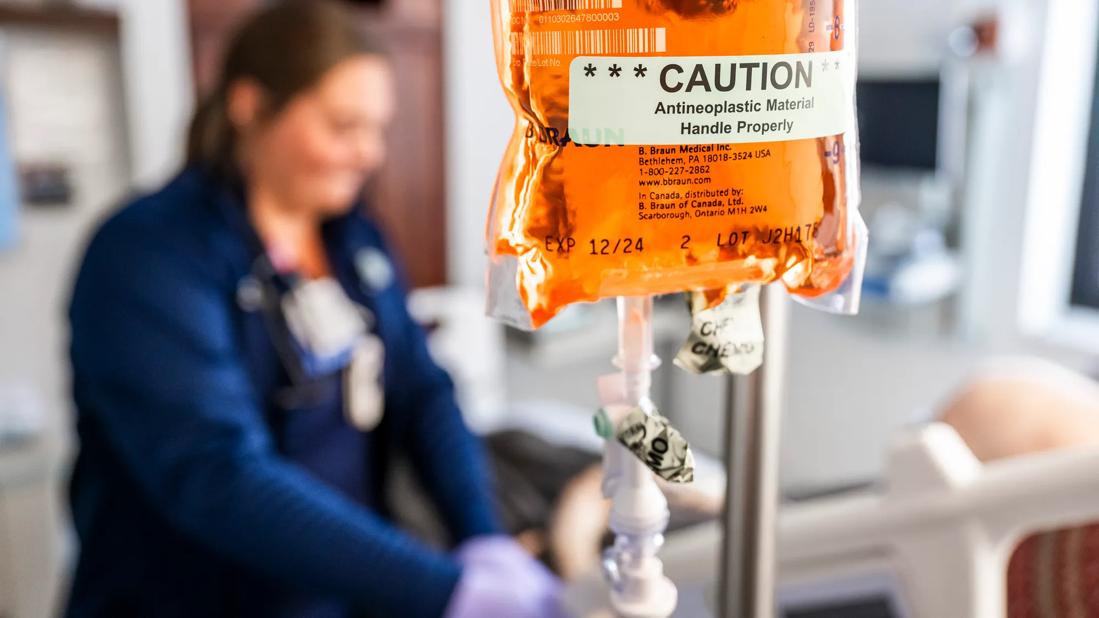New results from the BLASST-1 trial show increases in downstaging and relapse-free survival

New data from the Bladder Cancer Signal Seeking Trial (BLASST-1) reinforces the safety and efficacy of combination treatment with nivolumab, gemcitabine and cisplatin in patients with muscle-invasive bladder cancer (MIBC). The findings also suggest that basal-type tumors may respond more favorably than luminal tumors to the chemo-immunotherapy regimen.
Advertisement
Cleveland Clinic is a non-profit academic medical center. Advertising on our site helps support our mission. We do not endorse non-Cleveland Clinic products or services. Policy
Presented recently at the American Society of Clinical Oncology’s (ASCO’s) 2022 Genitourinary Cancers Symposium, the results are from a biomarker analysis and updated follow-up of participants in the phase II trial, who were originally enrolled in BLASST-1 between February 2018 and June 2019.
“These patients did very well, with a recurrence-free survival rate of 85.4% and a progression-free survival rate, including death from any cause, of 83%,” explains study coauthor Shilpa Gupta, MD, Director of the Genitourinary Medical Oncology at Cleveland Clinic’s Taussig Cancer Institute.
Forty-one patients participated in the study, 90% of whom had T2N0 disease at baseline, 7% of whom had T3N0 disease and 3% T2-4N1. The subjects were predominantly male (63%); the median age was 66 years.
Patients were treated with gemcitabine-cisplatin plus nivolumab, followed by radical cystectomy within eight weeks. Thirty-eight patients received four cycles, two received two cycles and one was treated with a single cycle of the combination therapy. All patients underwent surgery.
Nivolumab is a checkpoint inhibitor that blocks the programmed cell death protein 1/ligand 1 (PD-1/PD-L1) immune response pathway. Gemcitabine is an antimetabolite. Cisplatin is a DNA crosslinking agent.
In the original trial, the primary objective was to determine pathologic downstaging rates (paR); secondary objectives were to evaluate safety and progression-free survival (PFS) at two years; and exploratory objectives examined the association of PD-L1, RNA and DNA analysis with response.
Advertisement
Preliminary results from BLASST-1, presented at the ASCO Genitourinary Cancers Symposium in 2020, showed rates of pathological downstaging of advanced bladder cancer and complete response (pCR) of 66% and 49%, respectively, in patients who had received the immunotherapy/chemotherapy combination. The treatment was found to be safe, with no added toxicities from the combination.
For the follow-up study, an RNA-based analysis was conducted on tumors from 37 patients that passed quality control and for which transcriptome data were available. A cohort of patients treated with neoadjuvant chemotherapy plus radical cystectomy was used as a comparator for molecular subtyping analysis.
The analysis showed that the overall pathologic downstaging rate (PaR) was higher in the patients with basal-type tumors (basal or Claudin-low) at 73% (13 of 18) versus 58% for those with luminal-type tumors. Breaking down the luminal tumor group further, the authors found that 63% of patients (5 of 8) with luminal and 54% of patients with infiltrated luminal tumors (6 of 11) achieved PaR.
In contrast, in the comparator NAC cohort, PaR rates were similar for basal- and luminal-type tumors, at 44% and 48%, respectively. There was no correlation of PaR with tumor mutational burden or PD-L1 expression in baseline pretreatment tumors.
Biomarker analyses are being used to evaluate tissue obtained from residual tumors in patients who underwent radical cystectomy. The work is being done under a Department of Defense grant that calls for applying machine learning algorithms to generate a comprehensive biomarker. The goal is to identify biomarkers that can help predict whether patients with MIBC will be responsive or resistant to immunotherapy.
Advertisement
Also ongoing and being led by Dr. Gupta at Cleveland Clinic is the phase III ENERGIZE trial, which is evaluating gemcitabine/cisplatin alone versus gemcitabine/cisplatin plus nivolumab for the treatment of advanced bladder cancer. The outcome, she says, should further illuminate findings from the BLASST-1 study.
“The results from the follow-up study are encouraging,” notes Dr. Gupta. “The insights from the whole-genome sequencing and RNA-based analysis provide us with some direction on how to move the field forward by using personalized treatment approaches based on the early analysis of patient tissue. Oncologists also can help advance our understanding of MIBC by enrolling their patients in clinical trials.”
Advertisement
Advertisement

Care paths and research initiatives aim to answer unmet clinical needs

Study shows high rate of hematologic responses, low rate of disease progression

Bispecific antibody bridging therapy deepens durability of BCMA CAR T-cell therapy without overlapping toxicities in patients with relapsed/refractory multiple myeloma

Phase 2 study brings pivotal advances in treatment efficacy and safety for the most challenging-to-treat population

Patient with quadruple refractory multiple myeloma achieves complete response with cell therapy

Distinct baseline immune profiles can predict response and resistance to different types of CAR-T cells.

National Blood Clot Alliance collaborates with faith-based organizations on first-of-its-kind church bus tour

AI-driven tools can streamline enrollment and improve efficiency across clinical trials.